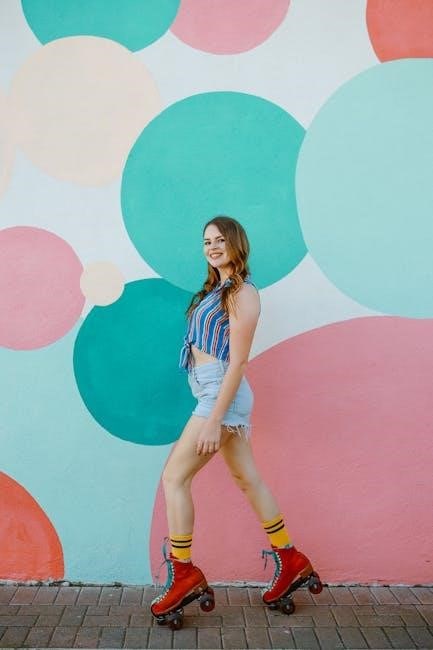Roller skating is a fantastic hobby combining fitness, fun, and freedom. With over 48 million participants annually, it’s making a comeback as a vibrant, timeless activity offering joy.
1.1 What is Roller Skating?
Roller skating is an exciting activity where participants wear skates with wheels to glide on surfaces. It can be done recreationally, competitively, or as a mode of transportation. The two main types of roller skates are quad skates, with four wheels arranged in a square, and inline skates, with wheels in a single row. Roller skating is enjoyed by people of all ages and skill levels, offering a fun way to stay active while exploring creativity and freedom. Its resurgence in popularity has fostered vibrant communities, making it a timeless and accessible activity for everyone.
1.2 Benefits of Roller Skating
Roller skating offers a perfect blend of fitness and fun, making it an excellent recreational activity. It provides a great workout, improving cardiovascular health, burning calories, and strengthening muscles. Skating enhances balance, coordination, and overall physical fitness while being low-impact, reducing stress on joints compared to high-impact sports. Mentally, it boosts confidence, reduces stress, and offers a sense of accomplishment. Roller skating is also a social activity, fostering connections and camaraderie within communities. Whether for recreation, exercise, or competition, it caters to all ages and skill levels, making it a versatile and rewarding hobby for individuals and families alike.
1.3 Why Roller Skating is Making a Comeback
Roller skating has seen a resurgence in popularity, driven by its nostalgic appeal and the growing desire for fun, outdoor activities. The COVID-19 pandemic played a significant role, as people sought affordable, socially distanced entertainment. Social media platforms like TikTok, with over 200 million posts tagged, have further fueled its comeback, showcasing skating as both retro and trendy. The activity’s versatility—whether for fitness, recreation, or competitive sports—appeals to diverse audiences. Its inclusive nature and the sense of community it fosters have also contributed to its revival, making roller skating a beloved pastime for both new and returning enthusiasts.

Choosing the Right Equipment
Selecting proper roller skating gear ensures comfort, safety, and performance. Essential items include skates, helmets, knee pads, and wrist guards to protect against injuries during learning.
2.1 Types of Roller Skates
Roller skates come in various types, each designed for specific activities. Quad skates are traditional, with four wheels in a square configuration, ideal for rink skating, dancing, and general use. Inline skates, or rollerblades, feature a single row of wheels, offering speed and agility, perfect for sports like hockey or fitness skating. Speed skates are built for velocity, with lightweight frames and durable wheels, suitable for competitive racing. Outdoor skates have larger, tougher wheels to handle rough surfaces. Choosing the right type depends on your skating style and preferences, ensuring optimal performance and enjoyment.
2.2 Safety Gear Essentials
Safety gear is crucial for protecting yourself while roller skating. A helmet is essential to safeguard your head from injuries, especially for beginners. Knee pads and wrist guards protect your joints from scrapes and bruises during falls. These items provide confidence and comfort, allowing you to focus on learning and enjoying the sport. Additionally, a mouthguard is recommended for added protection, particularly in crowded rinks or competitive settings. Investing in quality safety gear ensures a safer and more enjoyable roller skating experience. Always wear these essentials to minimize risks and maximize fun on the rink.
2.3 Roller Skate Plates and Trucks
Roller skate plates and trucks are vital components that determine how your skates perform. The plate is the base attached to the boot, while the trucks are metal axles that hold the wheels. Together, they influence maneuverability, stability, and responsiveness. Plates are typically made of aluminum or nylon, with aluminum being more durable and nylon offering flexibility. Trucks vary in width and angle, affecting turning radius and control. Proper alignment and tightness of these parts ensure smooth skating. Upgrading plates or adjusting trucks can customize your skates to suit your skating style, whether for speed, dance, or casual cruising.

Basic Techniques for Beginners
Mastering basic techniques like standing, walking, gliding, and stopping is essential for building confidence and a strong foundation in roller skating, ensuring a smooth learning process.
3.1 Standing and Balancing
To start, place your feet shoulder-width apart and bend your knees slightly, lowering your body into a comfortable squatting position. Keep your weight centered over your heels to maintain balance. Lean slightly forward, with your back straight and arms relaxed by your sides or extended for stability. Avoid leaning backward, as this can cause you to lose balance. Practice shifting your weight gently from side to side to get accustomed to the movement of the wheels. If you feel unsteady, crouch lower and focus on keeping your center of gravity over your skates; Regular practice will help build confidence.
3.2 Walking and Gliding
Begin by assuming the proper stance and slowly walking forward with a “duck walk,” keeping your knees bent and weight centered. With heels together and toes pointed out, alternate pushing off with one foot and then the other. As you gain confidence, extend your strides and allow yourself to glide on one foot while lifting the other. Practice switching gliding feet and use your body weight to steer by leaning slightly in the desired direction. Keep your arms relaxed and use them to help maintain balance. Gradually increase your speed by applying more pressure on the wheels. Remember to practice stopping confidently to avoid losing balance.
3.3 Learning to Stop
Mastering how to stop is essential for safe and confident roller skating. Start by gliding with your skates parallel and in a squatting position. To stop, place your right skate slightly in front of the left, lift the toe of the right skate, and press down firmly on the brake. Apply consistent pressure for a smooth stop. For an alternative method, try the “heel-toe” stop by skating on the heel of one foot and the toe of the other. Practice stopping slowly at first, keeping your knees bent and weight centered. Avoid leaning backward to maintain balance. Regular practice will build your confidence and control.
Intermediate Skills
Intermediate skills build on the basics, enabling skaters to explore more dynamic movements. Mastering backward skating, turning, and crossover turns enhances agility and control, while jumping adds excitement.
4.1 Skating Backward
Skating backward is an essential intermediate skill that enhances overall control and agility. To start, position your feet in an inverted V shape, with toes together and heels apart. Bend your knees, maintain a low center of gravity, and keep your weight evenly distributed; Practice gliding backward by applying pressure on your toes and using small, controlled movements. Turning while skating backward involves shifting your body weight and using your edges. Start slowly, focusing on balance and posture, and gradually increase your speed as confidence grows. This skill opens up new possibilities for maneuvering and adds versatility to your skating.
4.2 Turning and Crossover Turns
Mastering turns and crossover turns enhances your skating agility and control. To turn, lean your body in the desired direction while keeping your knees bent and weight centered. For a crossover turn, cross one skate over the other, using the edge of the back skate to push off in the new direction. Practice shifting your body weight and using your arms for balance. Crossover turns require timing and coordination but add fluidity to your movements. Start at a slow pace and gradually increase speed as you gain confidence. These techniques are fundamental for navigating curves and transitioning between directions smoothly.
4.3 Jumping and Advanced Tricks
Jumping and advanced tricks add excitement to your roller skating. Start with a basic jump: glide, crouch, and push off the ground. For a jump turn, combine jumping with a directional change. The heel-toe trick involves skating on one heel and the other toe. Crossover turns require crossing one skate over the other for sharp direction changes. Practice these moves to improve agility and style. Advanced tricks like these enhance your skating skills and open up new possibilities for creative expression on wheels.

Roller Skating Culture and Community
Roller skating has sparked a vibrant cultural renaissance, uniting diverse communities through shared creativity and passion, with over 200 million TikTok posts celebrating the trend.
5.1 The Roller Skating Renaissance
Roller skating has experienced a vibrant resurgence, becoming a cultural phenomenon that unites diverse communities. With over 48 million participants annually, it has evolved into a symbol of creativity and shared passion. The COVID-19 pandemic played a significant role in its revival, as people sought fun and freedom during challenging times. Social media platforms like TikTok, with over 200 million posts, have further fueled its popularity, showcasing skaters’ unique styles and tricks. This renaissance has brought together both nostalgic enthusiasts and newcomers, creating a thriving, inclusive culture that celebrates self-expression and joy on wheels. Roller skating is no longer just an activity—it’s a movement.
5.2 Joining a Roller Skating League
Joining a roller skating league is an exciting way to challenge yourself and connect with like-minded enthusiasts. Leagues like roller derby and roller hockey offer structured practices, competitions, and camaraderie. Whether you’re aiming to improve skills or compete, leagues provide a supportive environment to grow. Many cities host leagues, so finding one near you is easier than ever. If no league exists in your area, consider gathering friends to start your own! Roller skating leagues foster teamwork, creativity, and a sense of belonging, making them a rewarding way to immerse yourself in the sport and its vibrant culture.

Maintenance and Care
Regular cleaning and lubrication of bearings ensure smooth performance. Inspect wheels for wear and replace them when necessary. Store skates in a dry, cool place to prevent damage.
6.1 How to Clean and Maintain Your Skates
Proper maintenance ensures your roller skates perform optimally and last longer. Start by wiping down the boots with a damp cloth to remove dirt and sweat. Use a soft brush to clean between laces and crevices. For the wheels, remove debris with a toothbrush and clean with mild soap. Bearings should be lubricated regularly to reduce friction and noise. Inspect wheels for wear and replace them when necessary. Store your skates in a cool, dry place, away from direct sunlight, to prevent damage and extend their lifespan. Regular care keeps your skates in great condition for enjoyable skating sessions.
6.2 Storing Your Skates Properly
Proper storage is essential to maintain your roller skates’ condition and longevity. Store them in a cool, dry place, away from direct sunlight, to prevent damage and extend lifespan. Use a protective bag or wrap them in a cloth to shield against dust and moisture. Avoid leaving skates in damp environments or extreme temperatures. If storing for an extended period, ensure they are clean and dry to prevent mold or mildew. Consider storing wheels facing upwards to maintain their shape. Always check for storage-friendly features when purchasing, such as non-marking soles, to protect surfaces during storage. Proper storage ensures skates remain ready for your next adventure.